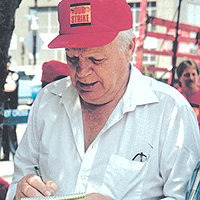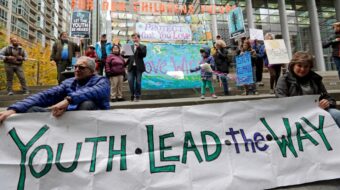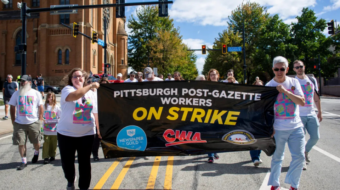EAST CHICAGO, Ill. – Bruce Gaddy is single. Tony McIntosh is married and has two children. Both live in this working-class suburb, 25 miles south of downtown Chicago. And both are unemployed: Gaddy because his plant closed, McIntosh because he was “down-sized” after working 22 years for AT&T.
Gaddy said looking for a job is “tough duty. These damn companies are pushing out the work and would do it without any workers if they could.” His weekly unemployment check is $269, less than half what he made at his last job.
McIntosh, who was drafted into the army of the unemployed in February 2002, said he thinks outfits like AT&T and “the rest of them” used Sept. 11 “as an excuse to kick people out of jobs.” He said his family had been able to get by because his wife still has her job. “We drew down my 401(k) and I’m able to pick up a job remodeling a kitchen or making a patio every once in a while. But you can get depressed if you think about the situation. It’s ugly out there,” he added.
Gaddy and McIntosh are not alone. The U.S. Labor Department’s April unemployment report shows unemployment climbed from 5.8 percent in March to 6 percent in April, the highest level since July 1994. The April numbers were particularly ugly for African Americans where the official count stood at 10.9 percent, nearly double the rate for all men. Even harder hit were young workers, where one in five was out of work last month.
According to a national survey of unemployed workers undertaken by the National Employment Law Project, the average unemployed worker has applied for jobs at 29 employers, while the average unemployed worker over age 45 has searched for jobs at 42 different employers. The same survey found 57 percent of respondents were forced to postpone medical or dental treatment for financial reasons while 56 percent said they had to cut back spending for food.
In April, 4.8 million persons – 600,000 more than a year ago – were working part time, even though they would have preferred a full-time schedule, while another 1.4 million workers were not counted as unemployed because, the Labor Department says, they were only “marginally attached” to the labor force. Taken together more than 14 million workers were either unemployed or underemployed in April.
Other negatives in the Labor Department’s April unemployment report include a $3.85 decline in weekly wages, the loss of 95,000 manufacturing jobs as factory employment fell for the 33rd consecutive month, and a drop in average working hours to the lowest level since 1983.
Overall, the economy grew by a miniscule 1.6 percent in April, far below the 5 percent many economists see as the level of sustained growth necessary if the unemployed are to find jobs. This slow growth has fueled predictions that the unemployment rate will continue to climb in the months ahead.
Paul L. Kasriel, director of economic research at the Northern Trust Company in Chicago, said he expects the rate to rise “at least’’ another two-tenths of a percentage point. “If the unemployment rate is not coming down by the middle of next year, the administration will have problems,’’ he said. “Right now, I’d say the odds of that happening are 50-50.” Other economists have said that even if the economy grows enough to reduce the number of unemployed by one million, the jobs picture will be no brighter than it was in 1992 when the first President Bush lost his bid for a second term.
Ellen Frank, a professor of economics at Emmanuel College in Boston, challenged that view. Pointing to the latest report of the Federal Reserve Board showing that manufacturing industries operated at only 72.9 percent of capacity in March, she said, “Bush’s economic plan is unlikely to create jobs or growth. The reality is that wealthy investors are already swimming in money and are unable to find sustainable growth avenues for their excess cash.”
Even Treasury Secretary John Snow questions the job-creating potential of the Bush plan which centers on tax cuts for the wealthiest one percent of the population. “I don’t look at it in terms of being a short-term stimulus package,” he said during recent congressional testimony.
AFL-CIO President John Sweeney called Congress to take prompt action to continue the extended unemployment benefit program enacted in 2002 and extended last January. “It is imperative that Congress not abandon long-term unemployed workers by ending the emergency jobless benefits program when it expires on May 15,” he said in a statement released May 5.
President Bush, on the other hand, continues to ignore calls for a federal extension of unemployment benefits for the long-term unemployed. Instead, he used the 0.2 percent increase in unemployment to buttress his demand congressional action on his “Jobs and Growth” program that will give tax cuts averaging $105,000 to those with annual incomes of more than $1 million. Claire Buchan, a White House spokeswoman, said Bush was focused on improving the economy, not extending jobless benefits. “People want jobs; they don’t want unemployment checks,” she said.
The author can be reached at fgab708@aol.com










